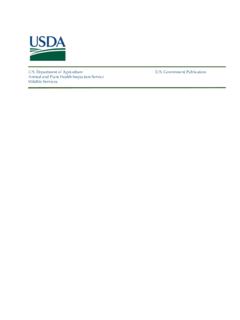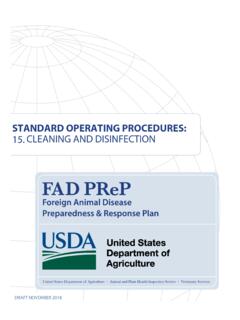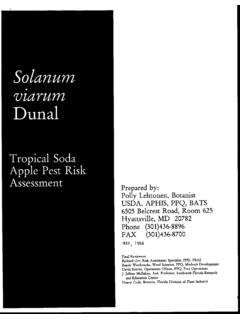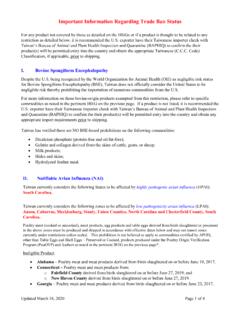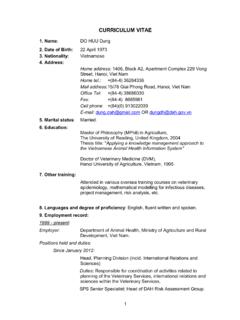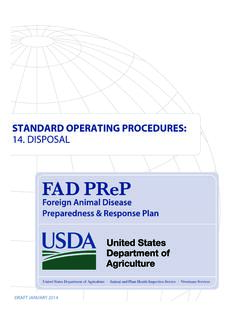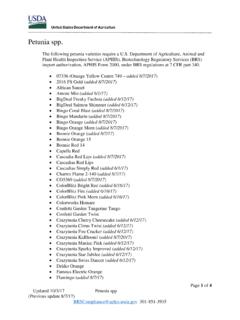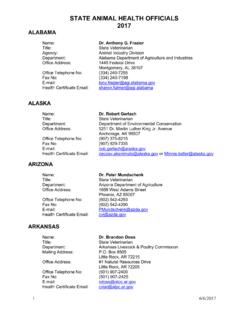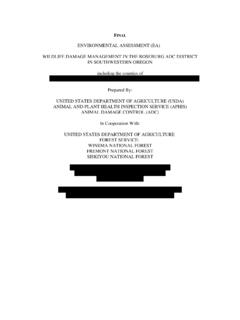Transcription of Discriminant Function Analysis - USDA
1 Discriminant Function Analysis Discriminant Function Analysis General Purpose Computational Approach Stepwise Discriminant Analysis Interpreting a Two-Group Discriminant Function Discriminant Functions for Multiple Groups Assumptions Classification General Purpose Discriminant Function Analysis is used to determine which variables discriminate between two or more naturally occurring groups. For example, an educational researcher may want to investigate which variables discriminate between high school graduates who decide (1) to go to college, (2) to attend a trade or professional school, or (3) to seek no further training or education. For that purpose the researcher could collect data on numerous variables prior to students' graduation.
2 After graduation, most students will naturally fall into one of the three categories. Discriminant Analysis could then be used to determine which variable(s) are the best predictors of students' subsequent educational choice. A medical researcher may record different variables relating to patients' backgrounds in order to learn which variables best predict whether a patient is likely to recover completely (group 1), partially (group 2), or not at all (group 3). A biologist could record different characteristics of similar types (groups) of flowers, and then perform a Discriminant Function Analysis to determine the set of characteristics that allows for the best discrimination between the types. To index Computational Approach Computationally, Discriminant Function Analysis is very similar to Analysis of variance (ANOVA).
3 Let us consider a simple example. Suppose we measure height in a random sample of 50 males and 50 females. Females are, on the average, not as tall as (1 of 11) [2/11/2008 8:56:30 AM] Discriminant Function Analysismales, and this difference will be reflected in the difference in means (for the variable Height). Therefore, variable height allows us to discriminate between males and females with a better than chance probability: if a person is tall, then he is likely to be a male, if a person is short, then she is likely to be a female. We can generalize this reasoning to groups and variables that are less "trivial." For example, suppose we have two groups of high school graduates: Those who choose to attend college after graduation and those who do not. We could have measured students' stated intention to continue on to college one year prior to graduation.
4 If the means for the two groups (those who actually went to college and those who did not) are different, then we can say that intention to attend college as stated one year prior to graduation allows us to discriminate between those who are and are not college bound (and this information may be used by career counselors to provide the appropriate guidance to the respective students). To summarize the discussion so far, the basic idea underlying Discriminant Function Analysis is to determine whether groups differ with regard to the mean of a variable, and then to use that variable to predict group membership ( , of new cases). Analysis of Variance. Stated in this manner, the Discriminant Function problem can be rephrased as a one-way Analysis of variance (ANOVA) problem.
5 Specifically, one can ask whether or not two or more groups are significantly different from each other with respect to the mean of a particular variable. To learn more about how one can test for the statistical significance of differences between means in different groups you may want to read the Overview section to ANOVA/MANOVA. However, it should be clear that, if the means for a variable are significantly different in different groups, then we can say that this variable discriminates between the groups. In the case of a single variable, the final significance test of whether or not a variable discriminates between groups is the F test. As described in Elementary Concepts and ANOVA /MANOVA, F is essentially computed as the ratio of the between-groups variance in the data over the pooled (average) within-group variance.
6 If the between-group variance is significantly larger then there must be significant differences between means. Multiple Variables. Usually, one includes several variables in a study in order to see which one(s) contribute to the discrimination between groups. In that case, we have a matrix of total variances and covariances; likewise, we have a matrix of pooled within-group variances and covariances. We can compare those two matrices via multivariate F tests in order to determined whether or not there are any significant differences (with regard to all variables) between groups. This procedure is identical to multivariate Analysis of variance or (2 of 11) [2/11/2008 8:56:30 AM] Discriminant Function AnalysisMANOVA. As in MANOVA, one could first perform the multivariate test, and, if statistically significant, proceed to see which of the variables have significantly different means across the groups.
7 Thus, even though the computations with multiple variables are more complex, the principal reasoning still applies, namely, that we are looking for variables that discriminate between groups, as evident in observed mean differences. To index Stepwise Discriminant Analysis Probably the most common application of Discriminant Function Analysis is to include many measures in the study, in order to determine the ones that discriminate between groups. For example, an educational researcher interested in predicting high school graduates' choices for further education would probably include as many measures of personality, achievement motivation, academic performance, etc. as possible in order to learn which one(s) offer the best prediction. Model. Put another way, we want to build a "model" of how we can best predict to which group a case belongs.
8 In the following discussion we will use the term "in the model" in order to refer to variables that are included in the prediction of group membership, and we will refer to variables as being "not in the model" if they are not included. Forward stepwise Analysis . In stepwise Discriminant Function Analysis , a model of discrimination is built step-by-step. Specifically, at each step all variables are reviewed and evaluated to determine which one will contribute most to the discrimination between groups. That variable will then be included in the model, and the process starts again. Backward stepwise Analysis . One can also step backwards; in that case all variables are included in the model and then, at each step, the variable that contributes least to the prediction of group membership is eliminated.
9 Thus, as the result of a successful Discriminant Function Analysis , one would only keep the "important" variables in the model, that is, those variables that contribute the most to the discrimination between groups. F to enter, F to remove. The stepwise procedure is "guided" by the respective F to enter and F to remove values. The F value for a variable indicates its statistical significance in the discrimination between groups, that is, it is a measure of the extent to which a variable makes a unique contribution to the prediction of group membership. If you are familiar with stepwise multiple regression procedures, then you may interpret the F to enter/remove values in the same way as in stepwise regression. (3 of 11) [2/11/2008 8:56:30 AM] Discriminant Function AnalysisCapitalizing on chance.
10 A common misinterpretation of the results of stepwise Discriminant Analysis is to take statistical significance levels at face value. By nature, the stepwise procedures will capitalize on chance because they "pick and choose" the variables to be included in the model so as to yield maximum discrimination. Thus, when using the stepwise approach the researcher should be aware that the significance levels do not reflect the true alpha error rate, that is, the probability of erroneously rejecting H0 (the null hypothesis that there is no discrimination between groups). To index Interpreting a Two-Group Discriminant Function In the two-group case, Discriminant Function Analysis can also be thought of as (and is analogous to) multiple regression (see Multiple Regression; the two-group Discriminant Analysis is also called fisher linear Discriminant Analysis after fisher , 1936; computationally all of these approaches are analogous).
